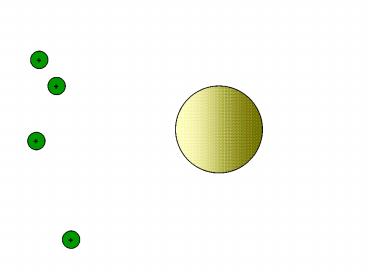Rutherfords Model of the Atom - PowerPoint PPT Presentation
1 / 59
Title:
Rutherfords Model of the Atom
Description:
Each spectral line has a particular frequency = particular photon energy ... Development of the CAT scanner (Computer Aided Tomography). SIR AARON KLUG ... – PowerPoint PPT presentation
Number of Views:40
Avg rating:3.0/5.0
Title: Rutherfords Model of the Atom
1
2
3
Rutherfords Model of the Atom
- Most of the atom is empty space.
- Most of the atoms mass and charge is located
at the center of the atom.
4
Next
- Bohrs model
- How a laser works
- X-ray production
- Wave-particle duality
- Quantum Physics
5
Exercise
- A radiostation broadcasts at 89.3 MHz with a
radiated power of 43.0 kW. - What is the magnitude of the momentum of each
photon? - How many photons does the radiostation emit each
second?
6
Exercise
- For a certain cathode material in a
photoelectric-effect experiment you measure a
stopping potential of 1.0V for light for
wavelength 600nm, 2.0 V for 400 nm, and 300nm for
300nm. Determine the work function for this
material and the value of Plancks constant.
7
Emission spectral
8
Things to consider
- Unique spectral lines for each element.
- Each spectral line has a particular frequency gt
particular photon energy - Heavy positively charge nucleus in the center of
the atom arounded by electrons.
9
- Attraction between negative electrons and
positived nucleus. - Rutherfords proposal
-
-
-
-
-
10
Bohrs model
- Electrons move around the nucleus at stable
orbits without emitting radiation. - Electron in one of these stable orbit has a
definite energy. - Energy is radiated only when electrons make
transitions from high energy orbit to a low
energy orbit.
11
hf
12
hf
13
- Energy is emitted as photons with energy
-
-
14
Quantifying the energy spectrum
- Bohr postulate that the angular momentum of an
electron revolving around a nucleus is quantized
in units of h/2p
15
- Newtons 2nd law yields
16
- The smallest radius is obtained by setting n 1,
is called the bohr radius.
17
- Kinetic energy of moving electrons
18
- Potential energy of electron bound to nucleus
19
Total energy of electron n-th orbital
20
Energy level diagram
- The possible energies which electrons in the atom
can have is depicted in an energy level diagram.
21
Bohrs model and the operation of the Laser
- In 1958, Charles Townes and Arthur Schawlow
theorized about a visible laser, an invention
that would use infrared and/or visible spectrum
light. - Light Amplification by Stimulated Emission of
Radiation- (LASER). - Properties of Lasers
- Produce monochromatic light of extremely high
intensity.
22
Bohrs model and the operation of the Laser
23
Bohrs model and the operation of the Laser
(Pumping the Laser)
24
Bohrs model and the operation of the Laser
25
Bohrs model and the operation of the Laser
26
Bohrs model and the operation of the Laser
27
Bohrs model and the operation of the Laser
28
Bohrs model and the operation of the Laser
29
Bohrs model and the operation of the Laser
30
Bohrs model and the operation of the Laser
31
Bohrs model and the operation of the Laser
32
X-ray production
- Properties of x-rays.
- High penetration gt High energy gtHigh frequency.
- X-rays are produced when acelerated electrons
strike a heavy metalic target (W).
33
Operation of an X-ray machine
34
X-ray production on the atomic scale
35
X-ray production on the atomic scale
36
ALLAN MACLEOD CORMACK 1924-1998
- Lecturer in Physics, University of Cape Town,
1950 - 1957 - Nobel Prize for Physiology and Medicine, 1979
- Development of the CAT scanner (Computer Aided
Tomography).
37
SIR AARON KLUG
- MSc student in Physics, University of Cape Town,
1946? - 1948 - Nobel Prize for Chemistry 1982
- Probing the properties of macromolecules (DNA)
with x-rays.
38
Wave-Particle Duality
- In the Bohr model, electrons orbit the atomic
nucleus in stable orbits. - What makes an orbit stable?
- Louis de Broglie proposed that subatomic
particles, such as electron, could exhibit some
wave behaviour.
39
De Broglies Wave Particle Model
- Similar to photons
- Wavelength of particle is related to its momentum
by
40
- where
41
Bohrs model with wavy electrons
- An electron orbit is stable if an integer number
of de Broglie standing wave can fit into it.
42
- General
43
- Yields
44
Wave Phenomenon
- Phenomenon associated with waves include
- Interference effects
- Reflection
- Refraction
45
Interference
- Superposition of wave pulse
46
Davidson-Germer experiment
- Aim to test if particle (electrons) exhibit
properties of waves i.e. Inteference. - Youngs experiment to find interference pattern
due to particle wave interaction.
47
?
48
Electron diffraction pattern
49
Scanning electron microscope images
50
(No Transcript)
51
Theory of Quantum mechanics
- Understanding the nature of the particle waves.
- Heisenbergs uncertainty principle
- Schroedingers equation.
- Spin-off of quantum theory in the todays world
52
Quantum Scale
53
Heisenbergs Uncertainty Principle
- On the scale on life size object a system is not
influenced by measurements on a system
(Deterministic system). - On the atomic scale a measurement on a system
will influence on it.
54
Finding the location of an electron
-
55
Finding the location of an electron
-
56
The Uncertainty Principle
- Act of measurement influences the electrons
state - Neither the position nor the momentum of a
particle can be determined with arbitrary great
precision
57
Schroedingers Wave Equation
58
- Heisenberg Uncertainty de Broglie waves
Schroedingers probabily waves function
59
Schroedingers solution to the electron orbitals
in the atom































